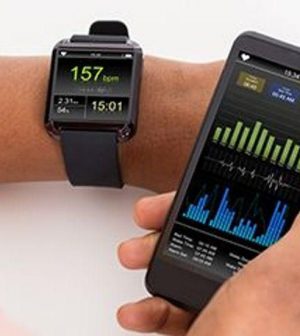- Navigating Your Midlife Crisis: Embracing New Possibilities
- City Raccoons Showing Signs of Domestication
- Mapping the Exposome: Science Broadens Focus to Environmental Disease Triggers
- One Week Less on Social Media Linked to Better Mental Health
- Your Brain Changes in Stages as You Age, Study Finds
- Some Suicide Victims Show No Typical Warning Signs, Study Finds
- ByHeart Formula Faces Lawsuits After Babies Sickened With Botulism
- Switch to Vegan Diet Could Cut Your Greenhouse Gas Emissions in Half
- Regular Bedtime Does Wonders for Blood Pressure
- Dining Alone Could Mean Worse Nutrition for Seniors
SmartWatches Detect Viral Infection Before Symptoms Surface in Study

Someday, your smartwatch might be able to tell you if you’re coming down with a virus and how sick you’ll be — even before symptoms start.
In a small study, researchers showed that a wearable device, like a Fitbit or Apple Watch, could detect which patients had the H1N1 flu and which had a common cold.
“One of our goals was to be able to detect that infection before a person feels symptoms, because they may be spreading pathogens without even knowing that they’re sick,” explained senior researcher Jessilyn Dunn, an assistant professor of biomedical engineering at Duke University in Durham, N.C.
The wristband does this by reading biological signs, including resting heart rate, heart rate variability and skin temperature, she said.
“The device detects illness and that your body is fighting something,” Dunn said. “We’re still working on trying to improve the distinction between different types of infections.”
Having this information can help patients by alerting them to contact their doctor, she noted. This, in turn, can help in planning how best to use limited resources in a time of crisis like the coronavirus pandemic.
“One of the ways that we think about it is for COVID-19. If we could actually predict who is going to be sick, and when, and how sick that person is going to be and what kind of care resources will they need, we could actually do a more intelligent triage and allocation of resources. So it gives us sort of a lens into the future,” she said.
Dunn foresees a future where everyone is wearing a smartwatch.
“In that future, where everybody does have a smartwatch, this would just be something that would be going on in the background. It would be a passive monitoring system, and that would give us an idea of who’s likely to be sick and how sick they’re likely to become,” she explained.
For the study, Dunn’s team gave 31 volunteers a nasal dose of H1N1 flu and 18 a common cold virus. Participants wore the sensor wristband for four days before and five days after inoculation.
Using only data from the wearable devices, the researchers could tell the difference between those infected and those not infected with up to 92% accuracy for H1N1 and 88% for the cold virus. The data could also distinguish between mild and moderate infection a day before symptoms started with 90% accuracy for H1N1 and 89% for the cold virus.
Infectious disease expert Dr. Marc Siegel, a clinical professor of medicine at NYU Langone Medical Center in New York City, said this might be an advance. But it will need more development and testing in a large number of people before it is ready for public use.
“This may not be a way to diagnose COVID or the flu, but it is a way to monitor metabolic changes to show that you’re getting the virus,” he said. “If you think about it, it’s not all that different than what we do when we take a temperature and a heart rate, and we have those monitors now.”
Ideally, Siegel would like to see such monitors be able to identify a variety of pathogens. Also, he wonders how this information might be used.
“If it’s accurate, it can be useful, because it could tell you in advance that you’re about to get sick, and then you can go get checked or stay home or have a cup of tea, whatever,” he said. “If this is useful in keeping sick people home and away from work, I’m all for it.”
The report was published online Sept. 29 in JAMA Network Open.
More information
For more on wearable biosensors, head to Arizona State University.
SOURCES: Jessilyn Dunn, PhD, assistant professor, biomedical engineering, Duke University, Durham, N.C.; Marc Siegel, MD, clinical professor, medicine, NYU Langone Medical Center, New York City; JAMA Network Open, Sept. 29, 2021, online
Source: HealthDay
Copyright © 2025 HealthDay. All rights reserved.










